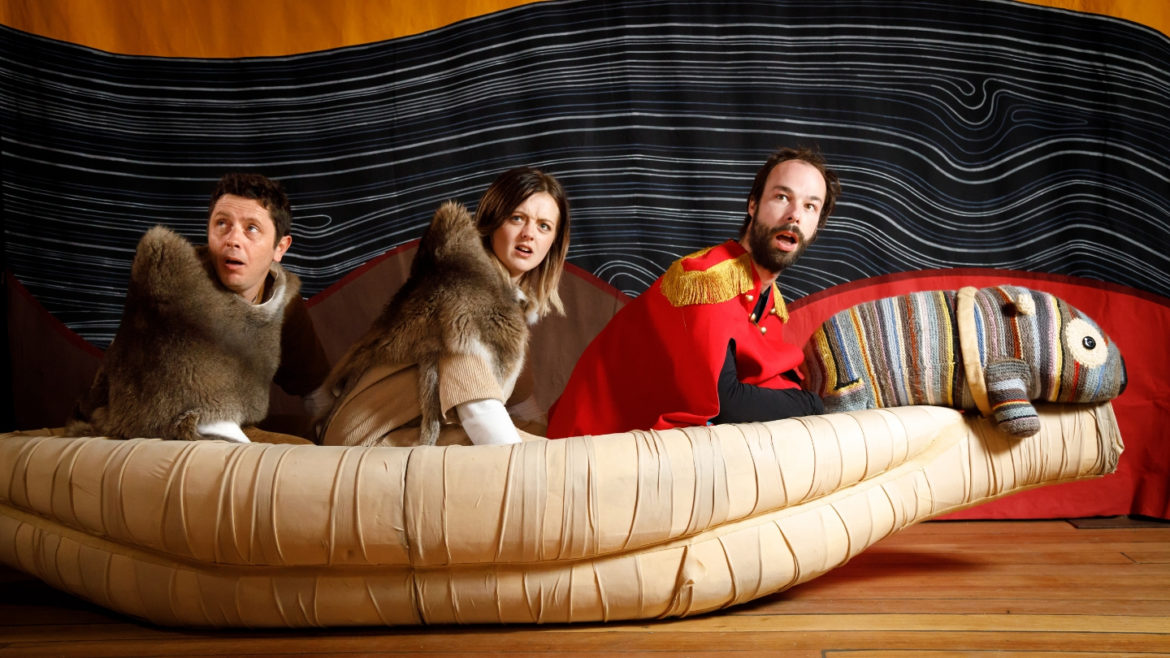Setting the bar high: youth correspondent Gully Thompson on the Melbourne season of Terrapin’s A Not So Traditional Story, opening soon at the Brisbane Festival
Educational theatre has a bit of a bad reputation. It can be a cheap way of conveying information, with corny jokes and flat storytelling.
I didn’t exactly have my hopes up for Terrapin’s A Not So Traditional Story at Arts Centre Melbourne, which came across pre-show as an educational experience. And I was very pleasantly surprised.
A Not So Traditional Story is, as the name suggests, a not-so-traditional interpretation of the story of white settlers first arriving in Australia. It tells the story of two kids, adventurous Wurangkili, and the more timid Timita, who encounter a strange man by the name of Riversong, who is searching for the Oldest of Oldest Elders. He carries a mysterious stick wrapped in cloth, which he claims is a strange object about which he wishes to ask the Oldest of Oldest Elders.
It turns out to be a telling of horrific acts of racism and genocide to a primary school audience, and this is where this excellent execution comes into play. In this story, the Riversong character is a white settler, and the mysterious stick is a gun with which he intends to kill the Elder, with so he may take over the land of Lutruwita. Riversong is portrayed as an alien who is invading Lutruwita. This is not only a good metaphor, but a clever way to interpret a child-friendly retelling of history.
The design of the show uses shadow puppetry and masks: the masks represent animal characters and the puppetry adds in a dreamtime story on the side of the main narrative. Both are beautifully, meticulously created and wonderful to watch (and the masks are created out of recycled materials!) It adds an excellent, almost surreal atmosphere to this story.
I did find, however, that while the story itself many not be so traditional, the way it was written may be. Our characters travel in a flying boat to seek the help of a Kangaroo, Lizard and Eagle to find the location of the Oldest of Oldest Elders. While they’re quite enjoyable, these three set pieces – which take up the bulk of the show – are written very similarly, and for me the repetitiveness diminishes the quality of the writing.
This is a shame, because this show is really written well. Interestingly, I found that the jokes that seem to be aimed at older audiences are funny (“I’m quite into music. I play lead clapsticks”), while some of the jokes for the younger audience members seem more forced. A lot of the younger jokes are modern references, which whilst seeming weirdly out of place, seemed to work quite well on our audience.
However, it should be considered that repetitive structure and set pieces are well-recognised as very effective methods to captivate young audiences. While I might not have enjoyed this element, I could clearly see that the younger audience did. In this case, I didn’t mind the use of these tactics, if it helps in getting the attention of the audience focused on a beautiful story.
The set pieces should not overshadow the work of the three animal characters – and our main characters, too. The animals have funny and unique personalities and add a great dynamic to the plot with the stories they tell and their interactions with the three other characters. The two children undergo growth and identity development throughout their experiences – something which is not seen commonly in children’s theatre.
Apparently, this show was originally written for three performers, one who would play the roles of the animals and the alien. The fourth cast member was added just before the show opened (which is, sadly, why this actor isn’t on any promotional material at all), and it seems the story wasn’t rewritten to include a fourth cast member.
The alien goes off behind set to attend to various different things as the animal characters come on stage. This comes off as quite strange to leave an actor out of the show for little reason, and while it would be nice for this to be rewritten, it’s probably not feasible to do so, considering these breaks tie into the plot.
Even if it has some flaws, behind this show is an excellent concept that conveys a sensitive topic to a young audience. While it doesn’t fully express the horrors and tragedy of the acts of white settlers, it still communicates the injustices committed against Indigenous Australians, and the emotional trauma they caused. It sets an example of how educational theatre should be written and performed, with captivating performances by all the actors – Jordy Gregg, Craig Irons, Nathan Maynard and Denni Proctor – and excellent design, masks and puppetry. A Not So Traditional Story sets the bar high for educational theatre traditions for years to come.
A Not So Traditional Story by Nathan Maynard, directed by Sam Routledge. Composition by Matthew Fargher, sets and costumes Michelle Boyde, puppet design and construction Bryony Anderson and Sabrina Evans, basket and water carrier construction Lillian Wheatley, creation story character design Lillian Wheatley, backdrop design and construction Michelle Maynard. Performed by Jordy Gregg ,Craig Irons, Nathan Maynard and Denni Proctor. Terrapin at Arts Centre Melbourne (closed), QPAC Brisbane Festival September 24-27. Bookings

